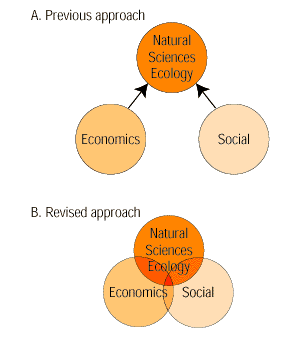4.1 Introduction
|

Figure 4.1: Evolution of approaches to carbon sequestration in
terrestrial ecosystems. Previous assessments (e.g., IPCC, 1996) tended
to focus on ecological processes and potentials, and treated economic
and social factors as constraints (A). A slightly different viewpoint
considers the three dimensions as mutually reinforcing and seeks to maximize
the overlaps (B).
|
Land is used to raise crops, graze animals, harvest timber
and fuel, collect and store water, create the by-ways of travel and the foundations
of commerce, mine minerals and materials, dispose of our wastes, recreate people’s
bodies and souls, house the monuments of history and culture, and provide habitat
for humans and the other occupants of the earth. Can land, and water, also be
managed to retain more carbon, and thereby mitigate the increasing concentration
of atmospheric carbon dioxide (CO2)? This chapter examines the present
scientific thinking on this question.
The atmosphere now contains about 760 billion tonnes (gigatonnes = Gt) of carbon
as CO2, an amount that has increased by an average of 3.3 ±
0.2GtC each year throughout the 1990s, mostly from combustion of fossil fuels
(IPCC, 2000a). Atmospheric C represents only a fraction (~ 30%) of the C in
terrestrial ecosystems; vegetation contains nearly 500GtC, while soils contain
another 2000 GtC in organic matter and detritus (Schimel, 1995; WBGU, 1998)
as cited in Intergovernmental Panel on Climate Change (IPCC) Special Report
on Land Use, Land-Use Change and Forestry (LULUCF) (IPCC, 2000a). Table
4.1 provides estimates of the carbon stocks in terrestrial ecosystems now.
The Second Assessment Report (SAR) of the IPCC (1996) suggested that 700Mha
of forestland might be available for carbon conservation globally – 138Mha
for slowed tropical deforestation, 217Mha for regeneration of tropical forests,
and 345Mha for plantations and agroforestry. The IPCC suggested that by 2050
this area could provide a cumulative mitigation impact of 60 to 87GtC, of which
45 to 72GtC in the tropics. Towards the end of this time interval, the mitigation
impact could approach a maximum rate of 2.2GtC/yr. The cost of mitigation (excluding
land and other transaction costs) was envisioned to be about 2 to 8US$/tC. The
SAR (IPCC, 1996) further suggested that, over the next 50 years, an additional
0.4 and 0.8GtC could be sequestered per year in agricultural soils, with the
adoption of appropriate management practices.
The current report, while supporting many of these earlier findings, provides
a broader evaluation of the potential for management of C stocks in the biosphere
(Figure 4.1). Recent studies, for example, suggest
that costs may often be higher than estimated earlier, particularly when opportunity
costs of the land are included. In addition, the issue of “leakage”
(where actions at one site influence actions elsewhere, a problem not considered
by the SAR) is examined. This report considers forests, grasslands, croplands,
and wetlands, and, where possible, examines all C pools within them. Carbon mitigation
is evaluated as one of many services provided by ecosystems. The objectives of
this chapter are to review progress made since the IPCC-SAR, and to evaluate prospects
for storing more carbon in ways that ensure the continued provision of other goods
and services from the varied and finite land resources.
Table 4.1: Estimates of global carbon stocks
in vegetation and soils to 1 m depth
(from Bolin et al., 2000; based on WGBU, 1998). |
 |
| Biome |
Area
|
|
Carbon stocks(GtC)
|
|
| |
(million km2)
|
Vegetation
|
Soils
|
Total
|
 |
| Tropical forests |
17.6
|
212
|
216
|
428
|
| Temperate forests |
10.4
|
59
|
100
|
159
|
| Boreal forests |
13.7
|
88
|
471
|
559
|
| Tropical savannas |
22.5
|
66
|
264
|
330
|
| Temperate grasslands |
12.5
|
9
|
295
|
304
|
| Deserts and semideserts |
45.5
|
8
|
191
|
199
|
| Tundra |
9.5
|
6
|
121
|
127
|
| Wetlands |
3.5
|
15
|
225
|
240
|
| Croplands |
16.0
|
3
|
128
|
131
|
|
|
| Total |
151.2
|
466
|
2,011
|
2,477
|
|
|
The aim of this chapter is not to assess specifically the implications of the
Kyoto Protocol (UNFCCC, 1997), a mandate assigned to the IPCC Special Report
on LULUCF (IPCC, 2000a). Rather, it seeks to provide a broader scientific view
of the prospects and problems of land management for carbon sequestration, unconstrained
by the limited scope of the Kyoto Protocol.
This chapter begins by describing the current state of land use, the history
of land use, ongoing changes in land use, pressures driving these changes, and
potential competition among demands for land (Section 4.3).
It then considers opportunities for enhanced C stocks, especially in forestry
and agriculture (Section 4.4). Having identified possible
C conservation measures, the physical, environmental, social, and economic impacts
of these measures are examined; and assessment is made of how they augment or
compete with other services provided by land (Sections 4.5
- 4.7). How these options might be evaluated and, where
appropriate, encouraged (Sections 4.8) is also considered.
Finally, the prospects for managing marine ecosystems to increase carbon sequestration,
and the possibility of managing the global ecosystem by ‘geo-engineering’
of the earth’s energy balance are considered.
Land-use changes and the pressures that influence them vary widely, especially
between tropical and non-tropical regions. Both of these regions are addressed.
